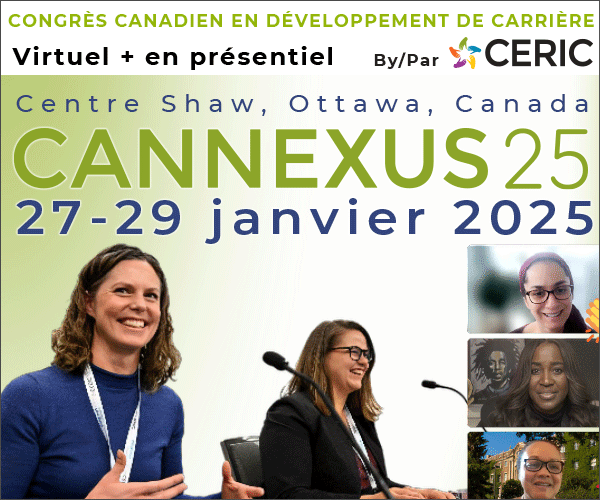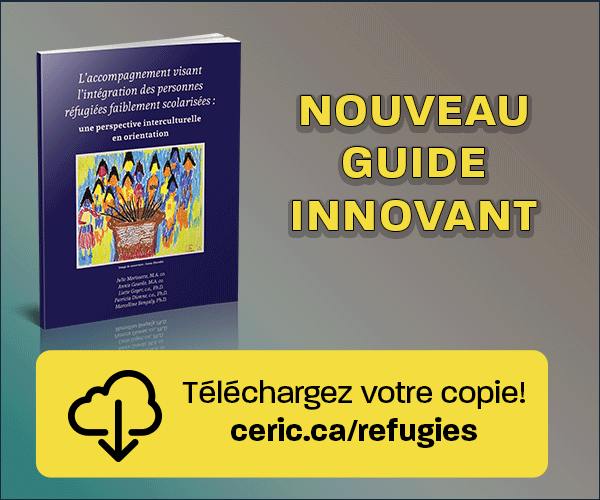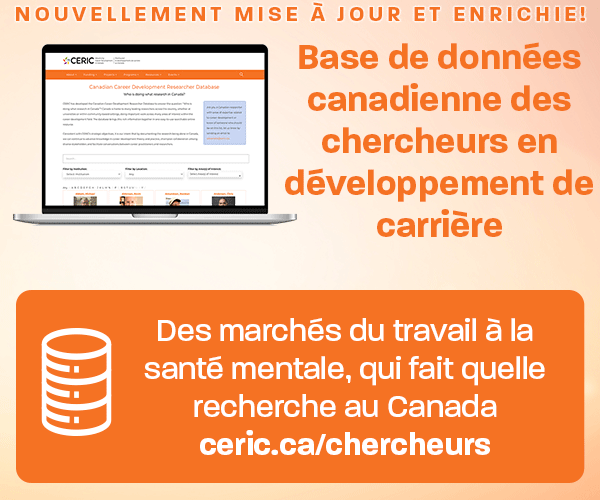Application de l'orientation professionnelle neuro-informée : Analyse d'une étude de cas unique
DOI :
https://doi.org/10.53379/cjcd.2024.380Mots-clés :
Neurosciences, l'orientation professionnelle, harcèlement moralRésumé
Cet article présente les résultats d'une analyse d'une étude de cas isolée sur l'application de l'orientation professionnelle informée proposée par Luke et Field (2007). Une recherche de sources académiques sur l'application des neurosciences à l'orientation professionnelle dans Google Scholar a donné peu de publications. Les seules publications dont le titre mentionne les neurosciences et l'orientation professionnelle comprennent un chapitre du livre de Luke et Field (2017) et un article de Dickinson, Miller et Beeson (2021). D'autres articles font référence aux neurosciences dans l'orientation professionnelle, mais dans l'ensemble, la contribution des neurosciences à l'orientation professionnelle reste limitée. Le présent article espère combler cette lacune dans la littérature en explorant la manière dont les théories neuroscientifiques peuvent être appliquées à l'orientation professionnelle. En réponse aux suggestions selon lesquelles l'orientation professionnelle nécessite davantage de recherches et de modèles pour prouver son efficacité (Bernes, Bardick, & Orr, 2007 ; Guindon & Richmond, 2005), cet article propose que les neurosciences puissent être appliquées à l'orientation professionnelle. Cet article propose que les neurosciences soient une discipline fructueuse à explorer pour cette raison.Références
Alon, U., Raz, M., Tendler, A., Bar, A., Kohanim, Y. K., & Milo, T. (2020). A new model for the HPA axis explains dysregulation of stress hormones on the timescale of weeks. Molecular Systems Biology, 16(7). https://doi.org/10.15252/msb.20209510
Berger, R. (2013). Now I see it, now I don’t:Rresearcher’s position and reflexivity in qualitative research. Qualitative Research, 15(2), 219–234. https://doi.org/10.1177/1468794112468475
Bernes, K. B., Bardick, A. D., & Orr, D. W. (2007). Career guidance and counselling efficacy studies: Aan international research agenda. International Journal for Educational and Vocational Guidance, 7(2), 81–96. https://doi.org/10.1007/s10775-007-9114-8
Boyatzis, R., Smith, M. L., & Oosten, V. E. (2019). Helping pPeople change: Coaching with Compassion for Lifelong Learning and Growth (1st ed.). Harvard Business Review Press.
Braun, V., & Clarke, V. (2013). Successful qualitative research: A practical guide for beginners (1st ed.). SAGE Publications Ltd.
Bryman, A. (2012). Social research methods (4th ed.). Oxford University Press.
Chen, C. (2001). On exploring meanings: Combining humanistic and career psychology theories in counselling. Counselling Psychology Quarterly, 14(4), 317–330. https://doi.org/10.1080/09515070110091308
Cochran, L. (1992). The career project. Journal of Career Development, 18(3), 187–197. https://doi.rg/10.1177/089484539201800303
Cowan, W. M., & Kandel, E. R. (2001). A brief history of synapses and synaptic transmission. Synapses, 1-87.
Cozolino, L. J., & Sprokay, S. (2006). Neuroscience and adult learning. New Directions for Adult and Continuing Education, 2006(110), 11–19. https://doi.org/10.1002/ace.214
Davis, M. (2002b). Role of NMDA receptors and MAP kinase in the amygdala in extinction of fear: Clinical implications for exposure therapy*. European Journal of Neuroscience, 16(3), 395–398. https://doi.org/10.1046/j.1460-9568.2002.02138.x
Dickinson, R., Miller, R., & Beeson, E. T. (2021). Leveraging neuroscience‐informed resilience principles to support clients’ career decision‐making. The Career Development Quarterly, 69(4), 340–354. https://doi.org/10.1002/cdq.12278
Donnelly, D., & Murray, E. (1991). Cognitive and emotional changes in written essays and therapy interviews. Journal of Social and Clinical Psychology, 10(3), 334–350. https://doi.org/10.1521/jscp.1991.10.3.334
Eisenberger, N. I., & Cole, S. W. (2012). Social neuroscience and health: Neurophysiological mechanisms linking social ties with physical health. Nature Neuroscience, 15(5), 669–674. https://doi.org/10.1038/nn.3086
Grant, A. M. (2015). Coaching the brain: Neuro-science or neuro-nonsense? The Coaching Psychologist, 11(1), 21–27. https://doi.org/10.53841/bpstcp.2015.11.1.21
Guindon, M. H., & Richmond, L. J. (2005). Practice and research in career counseling and development-2004. Career Development Quarterly, 54(2), 90–137. https://doi.org/10.1002/j.2161-0045.2005.tb00145.x
Hoare, P. N., McIlveen, P., & Hamilton, N. (2012). Acceptance and commitment therapy (ACT) as a career counselling strategy. International Journal for Educational and Vocational Guidance, 12(3), 171–187. https://doi.org/10.1007/s10775-012-9224-9
Huang, Z. L., Kirkwood, A., Pizzorusso, T., Porciatti, V., Morales, B., Bear, M. F., Maffei, L., & Tonegawa, S. (1999). BDNF regulates the maturation of inhibition and the critical period of plasticity in mouse visual cortex. Cell, 98(6), 739–755. https://doi.org/10.1016/s0092-8674(00)81509-3
Kirkwood, A., Rozas, C., Kirkwood, J., Perez, F., & Bear, M. F. (1999). Modulation of long-term synaptic depression in visual cortex by acetylcholine and norepinephrine. Journal of Neuroscience19(5), 1599–1609. https://doi.org/10.1523/JNEUROSCI.19-05-01599.1999
Kilgard, M. P., & Merzenich, M. M. (1998). Cortical map reorganization enabled by nucleus basalis activity. Science, 279 (5357), 1714–1718. https://doi.org/10.1126/science.279.5357.1714
Kim-Godwin, Y. S., Kim, S., & Gil, M. (2020). Journaling for self-care and coping in mothers of troubled children in the community. Archives of Psychiatric Nursing, 34(2), 50–57. https://doi.org/10.1016/j.apnu.2020.02.005
Krieshok, T. S., Black, M. J., & McKay, R. A. (2009). Career decision making: The limits of rationality and the abundance of non-conscious processes. Journal of Vocational Behavior, 75(3), 275–290. https://doi.org/10.1016/j.jvb.2009.04.006
Krumboltz, J. D. (1993b). Integrating career and personal counseling. Career Development Quarterly, 42(2), 143–148. https://doi.org/10.1002/j.2161-0045.1993.tb00427.x
Lieberman, M. D., Eisenberger, N. I., Crockett, M. J., Tom, S. M., Pfeifer, J. H., & Way, B. M. (2007). Putting feelings into words: Affect labeling disrupts amygdala activity in response to affective stimuli. Psychological science, 18(5), 421–428. https://doi.org/10.1111/j.1467-9280.2007.01916.x
Luke, C., & Field, T. A. (2017). Neuro-informed career-focused counseling. In T. A. Field, L. K. Jones, & L. A. Russell-Chapin (Eds.), Neurocounseling: Brain-based clinical approaches (pp. 195–209). American Counseling Association. https://doi.org/10.1002/9781119375487.ch12
Mariotti, A. (2015). The effects of chronic stress on health: New insights into the molecular mechanisms of brain–body communication. Future Science OA, 1(3). https://doi.org/10.4155/fso.15.21
Miller, R. (2016b). Neuroeducation: Integrating brain-based psychoeducation into clinical practice. Journal of Mental Health Counseling, 38(2), 103–115. https://doi.org/10.17744/mehc.38.2.02
Miller, G. E., Chen, E., & Zhou, E. S. (2007). If it goes up, must it come down? Chronic stress and the hypothalamic-pituitary-adrenocortical axis in humans. Psychological Bulletin, 133(1), 25–45. https://doi.org/10.1037/0033-2909.133.1.25
Myers, W. A., Churchill, J. D., Muja, N., & Garraghty, P. E. (2000). Role of NMDA receptors in adult primate cortical somatosensory plasticity. Journal of Comparative neurology, 418(4), 373–382. https://pubmed.ncbi.nlm.nih.gov/10713567/
Nevo, O., & Wiseman, H. (2002). Incorporating short term dynamic psychotherapy principles into career counseling: A theoretical and practical approach. Journal of Career Development, 28(4), 227–245. https://doi.rg/10.1177/089484530202800401
Nielsen, M. B., & Einarsen, S. (2012). Outcomes of exposure to workplace bullying: A meta-analytic review. Work & Stress, 26(4), 309–332. https://doi.org/10.1080/02678373.2012.734709
Nielsen, M. B., Tangen, T., Idsoe, T., Matthiesen, S. B., & Magerøy, N. (2015). Post- traumatic stress disorder as a consequence of bullying at work and at school. A literature review and meta-analysis. Aggression and Violent Behavior, 21, 17–24. http://dx.doi.org/10.1016/j.avb.2015.01.001
Pennebaker, J. W., & Seagal, J. D. (1999). Forming a story: The health benefits of narrative. Journal of Clinical Psychology, 55(10), 1243–1254. https://doi.org/10.1002/(sici)1097-4679(199910)55:10
Powers, J. J., & Duys, D. (2020). Toward trauma‐informed career counseling. The Career Development Quarterly, 68(2), 173–185. https://doi.org/10.1002/cdq.12221
Richman, D. R. (1993). Cognitive career counseling: A rational emotive approach to career development. Journal of Rational-Emotive & Cognitive-Behavior Therapy, 11(2), 91–108. https://doi.org/10.1007/bf01061234
Rogers, C. R. (1951). Client-centered therapy: Its current practice, implications, and theory. Houghton Mifflin.
Saunders, M.N.K., Lewis, P. & Thornhill, A. (2019). Research methods for business students, (8th ed.) Pearson.
Savickas, M. L., Nota, L., Rossier, J., Dauwalder, J. P., Duarte, M. E., Guichard, J., Soresi, S., van Esbroeck, R., & van Vianen, A. E. (2009). Life designing: A paradigm for career construction in the 21st century. Journal of Vocational Behavior, 75(3), 239–250. https://doi.org/10.4000/osp.2401
Shields, G. S., Sazma, M. A., & Yonelinas, A. P. (2016). The effects of acute stress on core executive functions: A meta-analysis and comparison with cortisol. Neuroscience & Biobehavioral Reviews, 68, 651–668. https://doi.org/10.1016/j.neubiorev.2016.06.038
Tehrani, N. (2004). Bullying: a source of chronic post traumatic stress? British Journal of Guidance & Counselling, 32(3), 357–366. https://doi-org.elib.tcd.ie/10.1080/03069880410001727567
Vyas, A., & Chattarji, S. (2004). Modulation of different states of Anxiety-Like behavior by chronic stress. Behavioral Neuroscience, 118(6), 1450–1454. https://doi.org/10.1037/0735-7044.118.6.1450
Zapf, D., & Gross, C. (2001). Conflict escalation and coping with workplace bullying: A replication and extension. European Journal of Work and Organizational Psychology, 10(4), 497–522. https://doi.org/10.1080/ 13594320143000834

Téléchargements
Publié-e
Comment citer
Numéro
Rubrique
Licence
(c) Tous droits réservés La Revue canadienne de développement de carrière 2024

Cette œuvre est sous licence Creative Commons Attribution - Pas d'Utilisation Commerciale - Pas de Modification 4.0 International.











